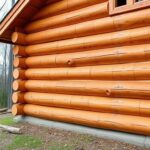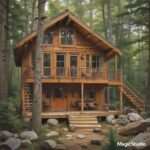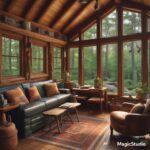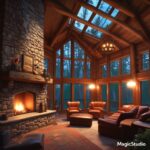In building or rebuilding a log house, sealing the gaps between logs is essential in terms of energy efficiency, weather tightness, and building stability. Though traditional thinking has been the norm for centuries, there have been some alternatives that make a difference. Additionally, being aware of the life span of the various chinking materials can help homeowners make maintenance decisions. This is a comprehensive guide that discusses the alternatives to traditional chinking and the predictors of chinking life.
Alternatives to Traditional Chinking
Log Home Gaskets and Energy Seals
One of the best substitutes for conventional chinking is gasket systems that are pre-installed during construction. Compressible foam or rubber gaskets are inserted between logs when they are being stacked, forming an invisible seal that does away with the need for chinking material to be seen.
High-performance gasket systems like Energy Seal and Log Builder Gasket provide excellent air and water seals and permit the natural settling of the logs. The gaskets are compressed by the settling of the logs but maintain their seal without creating the stress points that weaken conventional chinking.
The primary advantage of gasket systems is that they are not visible—they preserve the natural, smooth appearance of stacked logs without the contrasting lines leaving behind chinking leaves. However, this option is generally only feasible at initial construction or complete reconstruction, as retrofitting is extremely difficult.
Installation requires precision at the time of stacking the logs, and the gasket is typically placed in a pre-cut groove on the bottom of a log. Properly installed, these systems will last the life of the building with minimal or no maintenance.
Butt-and-Pass Construction
The butt-and-pass technique is a building technique that reduces or eliminates the need for chinking altogether. Logs are set so that they overlap corners without notching, and with each succeeding course, which logs go past and which butt up against them are reversed.
This building process creates tightly fitting, self-sealing corners in which the weight of the structure compresses the logs tightly together. The use of snug-fitting logs that close spaces, and chinking is significantly reduced or eliminated.
Butt-and-pass construction is also a favorite of do-it-yourself log home builders because it is so simple and needs less specialized equipment. It does need doing, though, with careful log selection and attention to detail when building so that there are no gaps to fill.
The look of butt-and-pass is dissimilar to a notched log building with traditional longer ends of logs on the corners. Some homeowners prefer the distinctive look of this, while others prefer the more traditional notched look.
Tongue and Groove Log Profiles
New milled log buildings tend to employ tongue and groove profiles that fit together when stacked in a way that leaves a natural seal between the logs. These accurately milled profiles reduce gaps and minimize or eliminate visible chinking.
In tongue and groove systems, the surface of a log has a projecting “tongue” and the surface underneath an equal “groove.” They interlock to create a watertight as well as airproof joint when one is placed on top of the other.
Other tongue and groove systems incorporate additional weatherproofing features like built-in gaskets or sealant channels that enhance their effectiveness. The precision milling used makes this option more common in factory-built log home packages than in hand-built homes.
While tongue and groove systems reduce chinking needs, most manufacturers recommend applying a thin bead of sealant at the joints for optimal weatherproofing, especially in extreme climate areas. This minimal sealant application is less intrusive and requires less material than traditional chinking.
Full-Scribe Method
The full-scribe method, or Swedish cope system, entails scribing all the logs precisely so that the logs fit tightly to the shape of the lower log. Extremely tight joints, which need minimal chinking, are created by this labor-intensive process.
Full-scribe workmen can form such a close joint that chinking can be felt only very slightly, though some do use a little chinking for aesthetics or additional weather insulation.
This process requires high skill and specialty equipment, hence it is more expensive than other forms of construction. It leads to great insulation characteristics and an upscale aesthetic appearance with the snug log fit.
Full-scribe homes typically have a narrow, discreet line of sealant between the logs rather than the wide strips of traditional chinking. It preserves the natural wood-on-wood appearance without compromising weatherproofing.
Here You Can Watch A Video On Tips. And Credits Goes To The Original Channel Owner (Log Chinking Tips).
How Long Does Log Chinking Last
The longevity of log chinking varies wildly depending on the type of material used, application quality, local weather, and maintenance practices. Having this information helps homeowners to set realistic expectations and maintenance strategies.
Lifespan of Traditional Chinking Materials
The initial chinking substances of mud, clay, and moss mixtures are typically effective for only 1-3 years before requiring major repairs or replacement. The substances dry out and shrink, creating gaps allowing air and water to penetrate. They also wash away with heavy rains and degrade rapidly in freeze-thaw conditions.
Cement mortars, popular during most of the 20th century, have improved durability compared to mud mixtures but are still extremely restricted. A typiPortlandland cement chinking installation will last 5-10 years before it will start to develop serious cracking problems and separation from the logs.
The main failure mode of cement chinking is its inability to accommodate log movement. As logs settle, shrink, and grow over time, hard cement cannot move with them, causing cracking and separation that breaks the seal.
Modern Synthetic Chinking Performance
New chinking materials are far more durable. High-quality acrylic and polyurethane chinking when used on surfaces that have been properly prepared will last 15-30+ years, subject to exposure and maintenance.
High-end brands such as Perma-Chink, Log Jam, and Sashco’s Conceal come with 5- to 10-year guarantees, with real-world performance typically lasting longer. The high elasticity of these products—most stretch 100% to 500% of their original size—means they will continue to seal despite log movement.
Properly installed synthetic chinking will typically fail in a gradual, rather than catastrophic, way. The material might show surface checking or slight separation at edges but otherwise maintain its fundamental weather-sealing capability, allowing for planned maintenance rather than emergency service.
Chinking Lifespan Determining Factors
Several key considerations decide how long any chinking installation will last:
- Climate Exposure: Houses with high-temperature fluctuation, high UV exposure, or high frequency of precipitation deteriorate chinking faster. Southern and west exposures weather faster than north exposures due to greater sun exposure.
- Log Movement: The degree of settling, shrinking, and expanding logs undergo influences chinking longevity. New log homes tend to settle more significantly in the initial years, subjecting chinking to more stress. Green (unseasoned) logs shrink more than kiln-dried or naturally seasoned logs, which can result in more chinking stress.
- Application Quality: Proper surface preparation, proper backing materials, proper application thickness, and proper tooling have a great impact on chinking performance. Chinking that is improperly applied—even with high-quality material—will fail within a few years, while properly applied products will last decades.
- Maintenance Procedures: Regular inspection and timely repair of minor defects extend chinking life substantially. Inspect chinking visually each year and seal minor cracks or separations before they expand and allow water intrusion that will destroy both chinking and the underlying logs.
- Log Treatments: Preservatives and finishes to logs influence the way they deal with chinking materials. Adhesion is impacted by some treatments, while improved adhesion occurs with others. Compatibility of chinking materials with systems of treatments to logs ensures better performance and durability.
Maintenance and Reapplication Instructions
Most log home construction experts recommend nd annual visual inspection of all chinking, preferably in spring after winter stresses have disclosed any likely deficiencies. Small gaps or cracks must be fixed instantly with the right repair material.
For conventional mud or cement materials, budget for undertaking major repairs every 1-3 years, which can involve replacement of the entire failed sections. The high maintenance needs of such materials are their biggest disadvantage.
Most chinking today requires little or no maintenance in the first 7-10 years other than normal visual inspections and occasional patching. After that, stricter maintenance might be necessary, but total replacement is rarely necessary before 15-20 years.
At the time of reapplication, most synthetic chinking does not have to be torn out at all if it has been doing a very poor job. New material may be applied over well-prepared existing chinking, which saves a great deal of labor.
Arriving at the Right Decision for Your Log Home
When choosing between chinking the old way and alternatives, or considering how long your chinking will last, keep these important considerations in mind:
- New vs. Restoration: The most flexible is new log home construction, including gaskets, tongue and groove systems, and chinking-reducing construction techniques. Existing homes will typically need to adapt to traditional or synthetic chinking unless being rebuilt completely.
- Aesthetic Appeals: Certain owners specifically want the classic contrasting lines of traditional chinking and find it to be a vital element of log home character. Others prefer the wood-to-wood look provided by options of gaskets and full-scribe construction.
- Climate Considerations: In harsh climates with wide temperature swings and gs, exposure to water, or sunlight, investing money in premium synthetic chinking or higher-end options usually provides the greatest long-term return on investment even if it is more expensive initially.
- Budget Realities: Although higher quality synthetic chinking can be 3-5 times more expensive than conventional products initially, their much longer life and lower maintenance needs usually place them at a cost savings in the long run. Labor savings from less frequent reapplication usually more than offset material cost savings.
- DIY vs. Professional: Some products like synthetic chinking can be installed perfectly by careful DIYers, while others like gasket systems and full-scribe construction typically require professional expertise for optimal results.
Conclusion
Both new chinking alternatives to conventional thinking and new chinking products are far better than the old method. In new construction, such options as gaskets, tongue and groove profiles, and full-scribe methods can avoid or reduce visible chinking and still provide great weatherproofing.
For new log homes or houses built with exposed chinking lines, contemporary synthetic materials provide a much longer-lasting product than natural materials. With normal application and maintenance, quality synthetic chinking will last 15-30+ years, while natural materials will last 1-10 years.
The ideal option for your particular case relies on the status of your log home at the time, your taste, the weather conditions where you live, and your finances. Knowing the possibilities and the durability factors will assist you in making good decisions that will help you improve the looks and functionality of your log home for years to come.










